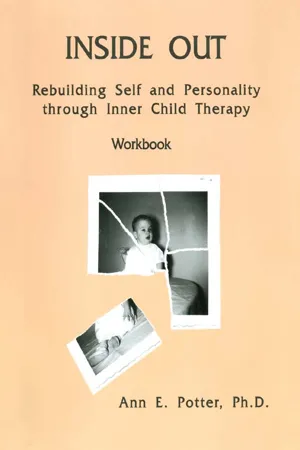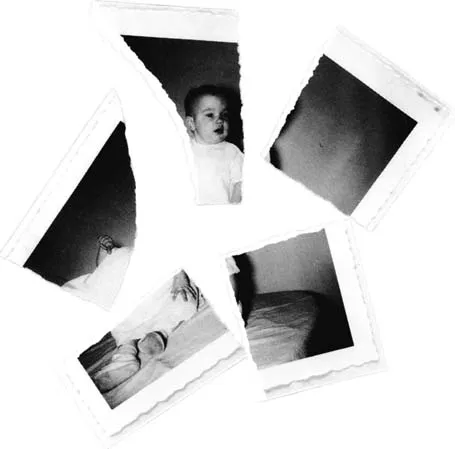![]()
PART I
OVERVIEW OF INNER CHILD THERAPY
![]()
THE PROCESS
Growing up in families with adults who have alcoholism or other compulsive behaviors, where feelings are not affirmed or expressed, and/or in which abuse or neglect occurred, affects people even into adulthood (Bradshaw, 1988; Kellogg & Harrison, 1990; Kritsberg, 1987; Woititz & Garner, 1990). Adult children develop their own compulsive or otherwise self-destructive behaviors. They may have problems in relationships or at work. They find themselves with a curious lack of feelings or overwhelming feelings. They may have difficulties raising their own children. Many times, adult children are very successful at relationships, at achieving, or in the work setting, but something inside still doesn't feel right. Perhaps, something inside feels like it's missing, or like a bomb is about to detonate, or just plain numb.
I had been in a 12-step program for three years when I began the first part of my own Inner Child work. I started to connect my inner sense of emptiness and nothingness, the depression and anxiety, the anger and despair, and relationship issues in my adult life with unresolved family of origin issues. After years of trying to fix my “outsides,” I began to examine early memories and experiences and to reclaim deeply repressed feelings. My healing eventually filled the nothingness I felt inside with a sense of wholeness. My inner sense of well-being and self-love led to a more positive way of thinking, letting go of self-defeating behaviors, and healthier way of relating to people and the world. Thus, Inner Child Therapy has become an “inside out” approach to healing childhood trauma and dysfunction.
Usually people who come to do Inner Child Therapy are at least in their mid-20s to early 30s. I have worked with clients even in their 50s and 60s. Some inner aspects of themselves (e.g., depression, anxiety, low self-esteem, nightmares, flashbacks, disturbing memories, a sense of emptiness, rages) and/or some outer aspect of their adult life (e.g., marital problems; parenting difficulties; sexual, relationship, or job issues) are out of balance. People come to Inner Child Therapy never before having been to therapy. They perhaps have seen or read John Bradshaw or participated in a group at their church. Sometimes, people come to Inner Child Therapy while in 12-step programs or after years of other types of therapy wondering why, after all the hard work they had done, they don't feel better inside.
MAIN STEPS
Inner Child Therapy is a step-by-step healing process for adults reared in dysfunctional families and who have unfinished business with their pasts. Inner Child (I.C.) Therapy contains five main steps:
1. Cognitive information about shame, childhood development, family dysfunction, abuse and neglect, and personality development with initial separation of the personality parts.
2. Telling the truth about childhood abuse and neglect.
3. Embracing and feeling the feelings.
4. Identifying the inner dialogue among the personality parts and ways in which present-day acting-out behavior is related to the dialogue.
5. Bringing about reintegration of the personality parts by healing the inner Child, reparenting the inner Child, empowering the inner Adult, and applying the I.C. process to adulthood issues.
In the first step, the client's emotional safety is insured by the creation of a safe place and a Higher Power for protection and nurturance. Essential to the process, the person is then safe from the negative messages that in the past had set off a self-destructive chain reaction of disbelief or minimization. Preliminary steps are taken to prepare for the feeling work to follow and to negotiate the pace of the healing. Cognitive information is given to provide a foundation for the feelings work to follow.
In the second step, the client then is able to tell the truth about the abuse and neglect from a position of safety.
In the third step, the person, as an adult, embraces and works through those feelings. The inner Child has gone through the experiences once before and so it is vital that the inner Child remain in its safe place with its Higher Power, free to be a child, while the person does the present-day work. People are educated in detail about types of abuse and the long-term effects of abuse and then do lists of the occurrences of abuse and neglect in their childhoods. They write letters to and from their inner child(ren) to restart a healthy communication pattern and reestablish the leadership of the Adult part of the personality (with the help of a Higher Power).
In the fourth step, people recognize their unique pattern of inner dialogue among the personality parts and how that dialogue is related to adulthood behaviors and patterns of interaction. Once identified, these behaviors lose their significance and their power.
The fifth step includes reintegrating the personality parts in a functional way. First, the internal negative messages are uncovered and real-life offenders (persons who perpetrated the abuse and neglect) are confronted symbolically in therapy. Feelings transferred to the inner Child during the trauma and carried by the Child part of the personality are returned to the real-life offenders. Unhealthy ties with real-life perpetrators are severed and new boundaries are set. The negative messages are transformed into a more positive way of thinking.
Next, the inner Child's role in the person's real life is clarified and the person learns new boundaries and the skills needed for safe and healthy development. Finally, the Adult part of the personality is empowered by the recognition of and the refuting of negative, self-messages and converting those messages into affirmations. The client is then ready to make new choices about present-day behaviors and about letting go of the past. Forgiveness then can be a decision to let go of unhealthy relationships springing from a solid base of adult self-love and functional boundaries. Adulthood issues can be viewed and resolved through application of skills learned during the Inner Child Therapy process.
EXERCISES AND VISUALIZATIONS
The main purpose of the twenty-five exercises throughout the workbook is to assist people in working through the material in each chapter. Each exercise is designed to help clients: (a) personalize what they are reading; (b) be specific in reactions, giving examples, and ideas gained from visualizations; and (c) integrate thoughts, feelings, and actions.
The nine visualizations in the workbook text can be either read by the person using the workbook or by the person's therapist during sessions. The visualizations also are recited on an audiocassette so that people can comple...

